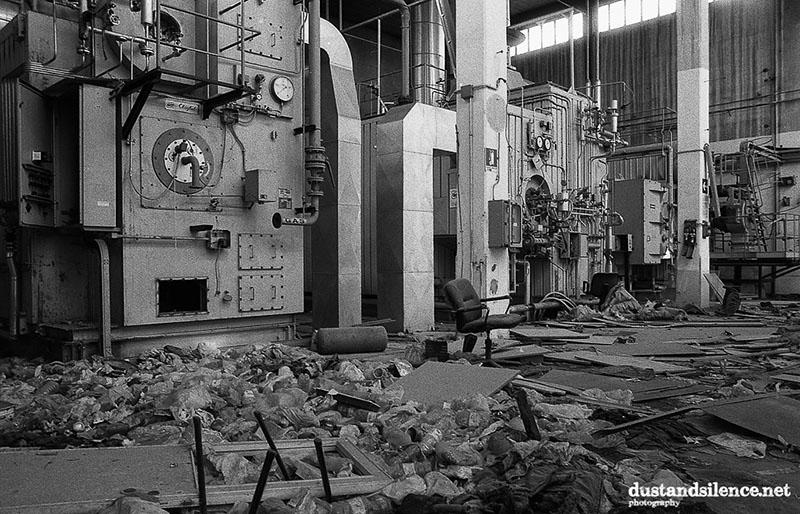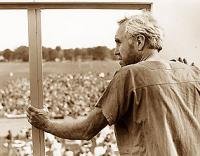On Sunday evening, November 20, 1983, thousands of Kansas Citians were part of the estimated 100 million Americans that watched the fictional destruction of Kansas City in the made-for-TV drama, The Day After. To an unprecedented scale, the controversial movie showed the potential effects of a full-scale nuclear war between the United States and the Soviet Union. Instead of highlighting political and military events, the film depicted the complete annihilation of Kansas City and focused on the resulting lives of the surviving residents of Lawrence, Kansas and rural areas of northwestern Missouri.

The possibility of a nuclear exchange between the two superpowers had been a major national concern since the U.S.S.R. developed nuclear weapons in 1949, but The Day After brought the abhorrent outcome of such an attack into the living rooms of Americans. The movie's creators selected Kansas City for ground zero because it was a typical Midwestern city in the center of the United States. Its destruction quite clearly demonstrated that a nuclear war would affect everyone. From a military perspective, it was realistic for the Soviets to target the area because of the large quantity of intercontinental ballistic missile silos in rural Missouri and Kansas.
The film struck a personal chord for Kansas City residents who saw Kansas City-area landmarks depicted on screen, including Liberty Memorial, the Kansas City Stockyards, the Truman Sports Complex, the downtown area, Union Station, KU Medical Center, and the Country Club Plaza. Preceding the attack, hundreds of panicked people were shown running through the streets and filing into a fallout shelter under a bank building in downtown. The actual rubble of old St. Joseph Hospital, which was being razed at the time, was a setting for a scene later in the film. The fictional wreckage of Liberty Memorial and a rubble-strewn downtown skyline also appeared.
The remainder of the plot following the destruction of Kansas City centered on Lawrence, Kansas and the rural areas of northwestern Missouri, where chaos reigned. While the special effects were limited to a made-for-TV budget, they still managed to chillingly depict the possible impact of a nuclear war. The film assumed that a complete breakdown of government infrastructure and services would occur, and it showed a harsh implementation of martial law. Meanwhile, the victims slowly died from radiation poisoning as they pondered which side had really started the war.

The publicity surrounding the film focused on the chilling effect it had on audiences and the political debates that it unleashed. Multiple "hot lines" staffed by psychologists around the country fielded thousands of phone calls from scared or depressed viewers. Viewers gathered with neighbors and at public locations such as the All Souls Unitarian Church in Kansas City to view the film with others. Immediately after the movie, ABC News presented a panel of scientists and political analysts to discuss the potential causes or outcomes of a nuclear war. A similar local program called Sunday, Nuclear Sunday aired on Kansas City's KMBC-TV, an ABC affiliate. It was anchored by local newsman Larry Moore and was intended to better inform the audience about nuclear politics. Reportedly, these programs failed to reassure most viewers that a nuclear war could be prevented. In a poll, 44% of Kansas City-area residents responded that nuclear war was likely in their lifetimes.
The Day After stirred considerable debate about nuclear arms policy and the Cold War. Different people drew varying conclusions from the film. Virtually all who saw the film agreed that nuclear war should be prevented at all costs, but no one could agree on how that goal should be accomplished. The anti-nuclear arms movement hailed the film as clear evidence that nuclear weapons should be abandoned wholesale. Conservatives retained the belief that the doctrine of mutually assured destruction (MAD) would prevent the U.S. and U.S.S.R. from ever pulling the nuclear trigger on each other.
Public reaction in Kansas City was equally diverse. Nearly 1,200 anti-nuclear activists held a candle-light vigil at the base of Liberty Memorial. Several rallies and forums were held around town in the following days. Religiously-oriented advertisements even appeared in the newspapers that made statements such as, "'THE DAY AFTER' IS TOO LATE! START NOW! Pastors lead your people to repent!" Other ads for shelter installation and other crisis preparation services simply stated, "How to Survive a Nuclear War."
Ultimately, The Day After was a chilling reminder that nuclear war remained a real possibility as long as the Cold War continued. The conflict finally eased with the fall of the Soviet Union by 1991, making it considerably easier to watch the movie without overt fear of an imminent nuclear war. Today, Kansas Citians can re-watch the movie that depicts the destruction of their city with a sense of entertainment and historical curiosity, devoid of the ongoing dread of apocalypse that the film originally elicited.
View images of Kansas City landmarks that are featured in the movie and are a part of the Missouri Valley Special Collections:
- Liberty Memorial; several of the movie's scenes depict Liberty Memorial before and after its fictional destruction.
- Union Station and Kansas City Skyline; as it appeared in 1989, four years after the movie depicted its fictional destruction.
Check out the following articles about "The Day After" and Cold War-era Kansas City, held by the Kansas City Public Library:
- "Kansas City after 'The Day After,'" by John Garrity, in Travel Holiday, June 1984; discusses an increase in tourism in Kansas City after the movie.
- "Keeping the Bomb at Bay," by Jennifer Sanner, in the Kansas City Magazine, August 1982; article about anti-nuclear weapon protests within the medical community.
- "The Missileers of Missouri: A Day on the Job with ICBM Launch Specialists," by Peter von Ziegesar, in the Kansas City Magazine, November 1987; informational article about the intercontinental missile silos in central Missouri.
- "Quiet Efforts toward an Elusive Goal: Peace," by Toni Wood, in the Kansas City Magazine, December 1988; details peace movement organizations in Kansas City.
- Barry Garron, "'Day After' Takes Arms Questions Straight to Viewers," The Kansas City Star, November 21, 1983.
Continue researching Kansas City's civil defense history using archival material held by the Missouri Valley Special Collections:
References:
Rick Montgomery & Shirl Kasper, Kansas City: An American Story (Kansas City, MO: Kansas City Star Books, 1999), 346.
Gregory S. Reeves, "Survey Finds Many Minds Clouded by Nuclear Specter," The Kansas City Star, November 22, 1983.
Advertisements, "It Doesn't Have to Happen," and "How to Survive a Nuclear War," The Kansas City Times, November 21, 1983.
"Movie Pushes Button for Nuclear Debate," The Kansas City Star, November 21, 1983.
Kevin Helliker, "'Day After' Yields Grim Evening," The Kansas City Times, November 21, 1983.
Barry Garron, "'Day After' Takes Arms Questions Straight to Viewers," The Kansas City Star, November 21, 1983.
Barry Garron, "'The Day After,' Actors were Different People," The Kansas City Star, November 20, 1983.
"'The Day After' Airs Amid Debate," Los Angeles Times, November 21, 1983.

